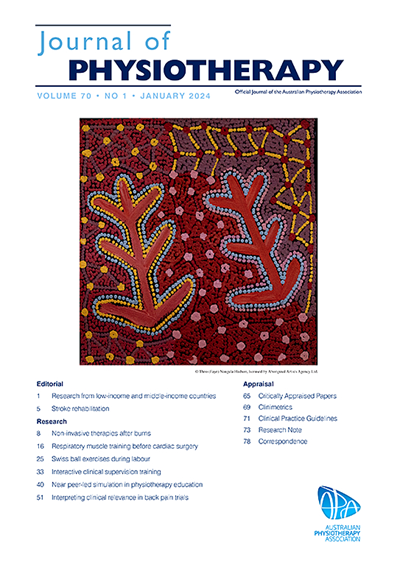An e-learning program improves low back pain beliefs of physiotherapists: a randomised trial
IF 9.7
1区 医学
Q1 ORTHOPEDICS
引用次数: 0
Abstract
Question
How effective is an e-learning program based on international clinical guidelines in promoting beliefs more aligned with the current evidence for the management of low back pain among physiotherapists?
Design
Randomised controlled trial with concealed allocation and intention-to-treat analysis.
Participants
106 physiotherapists who treat patients with low back pain.
Interventions
The experimental group received access to an e-learning program, based on recommendations of clinical practice guidelines for the management of low back pain, over a 6-week period. The program consisted of six units, totalling 15 hours, and was offered in a self-instructional and self-paced format. The control group was instructed to continue their activities as usual.
Outcome measures
The primary outcome was beliefs about low back pain measured using the Modified Back Beliefs Questionnaire (MBBQ, –50 worst to 50 best). Secondary outcomes included the Back Pain Attitudes Questionnaire (Back-PAQ, –20 worst to 20 best) and agreement with two statements (1: X-rays or scans are necessary to get the best medical care for low back pain; 2: Everyone with low back pain should have spine imaging). Participants were evaluated at baseline and 6 weeks.
Results
Out of 53 participants allocated to the e-learning program, two completed only the first unit and one did not complete any units, resulting in an overall adherence rate of 94%. Compared with control, the e-learning program improved the MBBQ (MD 8 points, 95% CI 5 to 10) and the Back-PAQ score (MD 3.1 points, 95% CI 1.8 to 4.3). For the imaging beliefs statements, the e-learning program was able to increase the proportion of participants with beliefs aligned with the current evidence (statement 1: RD 38%, 95% CI 21 to 52; statement 2: RD 17%, 95% CI 7 to 29) compared with the control group.
Conclusion
The e-learning program based on recommendations of clinical practice guidelines for the management of low back pain improved physiotherapists’ beliefs about the management of low back pain.
Registration
NCT05661968.
一个电子学习项目改善了物理治疗师对腰痛的看法:一项随机试验。
问题:一个基于国际临床指南的电子学习项目在促进信念方面的效果如何?它与物理治疗师治疗腰痛的现有证据更加一致?设计:随机对照试验,采用隐蔽分配和意向治疗分析。参与者:106名治疗腰痛患者的物理治疗师。干预措施:实验组接受了一个为期6周的电子学习计划,该计划是基于临床实践指南对腰痛管理的建议。该课程由六个单元组成,共15个小时,并以自学和自定进度的形式提供。对照组被要求继续他们的活动。结果测量:主要结果是使用修改后的背部信念问卷(MBBQ, -50最差到50最好)测量腰痛的信念。次要结果包括背部疼痛态度问卷(Back- paq,从-20最差到20最好)和对两项陈述的同意(1:x光或扫描是获得腰痛最佳医疗护理的必要条件;2:每个腰痛的人都应该做脊柱成像。在基线和6周时对参与者进行评估。结果:在分配到电子学习计划的53名参与者中,两人只完成了第一个单元,一人没有完成任何单元,导致总体依从率为94%。与对照组相比,电子学习计划改善了MBBQ (MD 8分,95% CI 5至10)和Back-PAQ评分(MD 3.1分,95% CI 1.8至4.3)。对于图像信念陈述,电子学习计划能够增加与当前证据一致的信念的参与者比例(陈述1:RD 38%, 95% CI 21至52;表述2:RD为17%,95% CI为7 ~ 29)。结论:基于腰痛管理临床实践指南建议的电子学习项目提高了物理治疗师对腰痛管理的信念。注册:NCT05661968。
本文章由计算机程序翻译,如有差异,请以英文原文为准。
求助全文
约1分钟内获得全文
求助全文
来源期刊

Journal of Physiotherapy
ORTHOPEDICS-REHABILITATION
CiteScore
11.40
自引率
7.40%
发文量
69
审稿时长
72 days
期刊介绍:
The Journal of Physiotherapy is the official journal of the Australian Physiotherapy Association. It aims to publish high-quality research with a significant impact on global physiotherapy practice. The journal's vision is to lead the field in supporting clinicians to access, understand, and implement research evidence that will enhance person-centred care. In January 2008, the Journal of Physiotherapy became the first physiotherapy journal to adhere to the ICMJE requirement of registering randomized trials with a recognized Trial Registry. The journal prioritizes systematic reviews, clinical trials, economic analyses, experimental studies, qualitative studies, epidemiological studies, and observational studies. In January 2014, it also became the first core physiotherapy/physical therapy journal to provide free access to editorials and peer-reviewed original research. The Australian Physiotherapy Association extended their support for excellence in physiotherapy practice by sponsoring open access publication of all Journal of Physiotherapy content in 2016. As a result, all past, present, and future journal articles are freely accessible, and there are no author fees for publication.
 求助内容:
求助内容: 应助结果提醒方式:
应助结果提醒方式:


